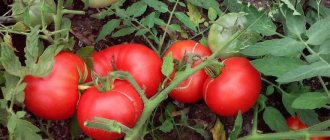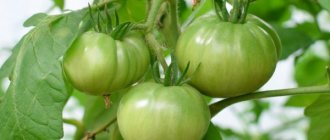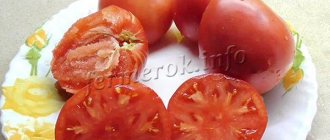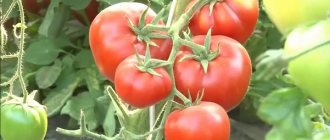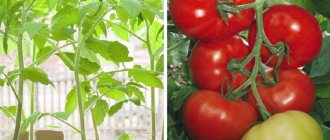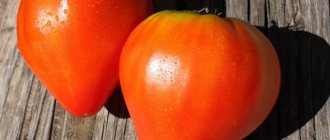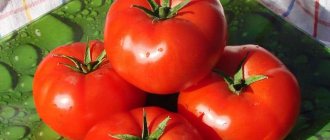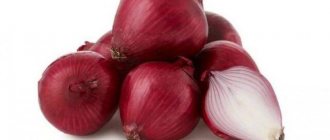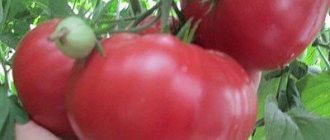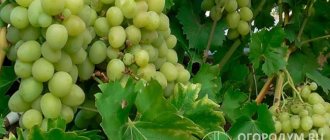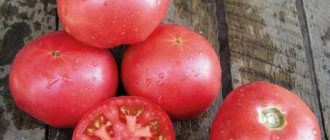When choosing a tomato variety for their plot, summer residents are often tormented by doubts about what is best to plant? Large-fruited or, conversely, smaller? For summer salads or for pickles and marinades?
Often, the lack of space does not allow planting many varieties, but you really want to eat plenty in the summer and prepare for the winter. It is for the sake of variety that the Katrina tomato was created, allowing you to enjoy ripe vegetables of excellent taste both in summer and winter. Let's get to know him better.
Characteristics and description
The originator of the hybrid tomato Katrina f1 is Lyubov Anatolyevna Myazina . The culture was included in the State Register in 2008. It is recommended for cultivation in open ground and greenhouse conditions.
Reference. Myazina L.A. is a famous Russian breeder, the author of not only tomato crops, but also the creator of cucumbers and peppers.
Distinctive features
The culture belongs to the determinant type, height from 60 cm to 1.2 m . The foliage is medium, the leaves are small, bright green. The stem is strong, but plant staking is required. The inflorescences are simple. Each fruiting branch bears 5–7 fruits in all weather conditions.
When propagated in open ground, bush formation and pinching are not required .
An early ripening hybrid, 85–95 days pass from the moment of sowing the seeds to full ripening. Productivity is high , from 1 sq. m, up to 5 kg of fruits are collected, when placing 4–5 seedlings per 1 sq. m.
The genes of the hybrid contain high resistance to dangerous diseases of the nightshade family.
Fruit characteristics
Average weight 150–200 g, round shape, bright red color . The taste is excellent, the flesh is juicy. The skin is dense and does not crack, which allows you to store ripe vegetables for a long time and transport them over any distance. Tomatoes can also withstand heat treatment, so the fruits look great when preserved.
The taste qualities go well with yellow tomatoes , so they are often mixed in winter preparations, obtaining not only a beautiful appearance, but also an excellent taste. Ripe vegetables are great for preparing any fresh dishes and for processing into tomato products.
The photo shows tomatoes Katrina f1.
Description and characteristics of the tomato variety
Katrina tomatoes have excellent characteristics that have made them one of the most popular and frequently planted among experienced farmers and gardeners, as well as among summer residents:
- This variety of tomatoes is distinguished by early ripeness; the first fruits can ripen already on the 80th day from the moment the seeds are planted in open ground.
- The bushes are quite large in size, with a lush deciduous crown, reaching from 85 to 125 cm in height and over half a meter in diameter.
- The foliage is rich green in color, soft and silky to the touch.
- The stem is strong, elastic and quite thick, which allows it to support such a crown and many fruits.
- On average, about 5 kg of fruit can be harvested from one tomato bush of this variety per season. The fruits are round, fleshy, and bright scarlet in color. The average weight of one tomato varies in the range of 150–250 g. Inside they have a uniform and uniform texture, are pleasant to the taste and have a pronounced tomato aroma.
- Suitable for both home cultivation in small quantities on your own plot, and for large-scale production in greenhouses and open fields.
- They are unpretentious in care and maintenance, easily adapt to temperature and weather conditions, and withstand temperature fluctuations characteristic of a temperate continental climate.
How to grow seedlings
Many varieties are grown in seedlings and the Katrina tomato is no exception. It will not be possible to collect seed material on your own, since the crop is hybrid.
Seed preparation
As a rule, before releasing seed for sale, the manufacturer takes care of the quality of the product. Therefore, purchased seeds are not disinfected; they are already disinfected and ready for sowing . But to improve germination, grains are soaked in a growth stimulator for 10 hours. As soon as the seeds swell, they are sown in the ground.
Reference. Most often, the drug “Epin” or melt water is used as a stimulant.
Container and soil
The soil is prepared from garden soil mixed with humus and wood ash in equal quantities . Superphosphate is added to the resulting mixture as fertilizer. After thorough mixing, the soil is steamed in the oven at a temperature of 50 ° C for 15 minutes or spilled with a hot solution of potassium permanganate. In this way, pathogenic flora is destroyed.
Reference. Self-prepared soil is subject to mandatory disinfection. Pathogenic spores contained in the soil can cause irreparable harm to young plants.
After the soil has cooled, it is laid out in planting containers , filling them halfway. Subsequently, as the seedlings grow, soil is poured into containers, providing the necessary nutrition throughout the entire seedling period.
You can plant in a common wooden box and in separate cups : plastic or peat. Peat cups are considered an ideal option for growing seedlings, since the seedlings do not need to be picked and transplanted into the soil from a container - the seedlings are lowered into the holes along with the cup. This is due to the fact that the tomato tolerates picking and transplanting too painfully, and then takes a long time to take root in the new conditions.
Important! Picking and replanting will delay the fruiting period.
Sowing
Seeds are sown 2 months before planting in the ground . They are buried 1 cm with a distance of 2 cm from each other. Sprinkle soil on top and lightly compact. Moisten with warm, settled water from a spray bottle and cover with film to create greenhouse conditions.
After this, the seeded containers are left in a bright and warm room at a temperature of 22–24 °C. At temperatures below 18 °C, seedlings will appear later and seedlings will noticeably lag behind in development.
How to grow tomatoes
Transplantation is carried out as soon as 6–7 true leaves are formed on the bushes , and the soil warms up to 15 ° C. The soil is prepared in the fall - it is dug up and a complex of mineral fertilizers is applied.
Landing
In spring, the soil is dug up again two weeks before transplanting. The holes are made no deeper than 20 cm and a little superphosphate is placed at the bottom of each. Replant in clear weather in the evening after sunset.
Planting pattern : 40 cm is the distance between seedlings, 50 cm is left between rows. For 1 sq. m place no more than six plants.
The holes are covered with earth and watered with warm, settled water . The plants get used to the new place within ten days. During this time, they are not watered or fed, since all the seedlings’ efforts are aimed at adaptation.
Further care for the Katrina tomato
Tomato does not require close attention and complex agricultural technology . Proper care comes down to regular moderate watering and timely application of fertilizing.
Regular watering is established as the seedlings take root in a permanent place . Water as the top soil layer dries out, without flooding the plants. The water is settled and heated in large barrels exposed to the sun, since the hybrid does not like cold water.
After watering, the soil is loosened and hilled up to improve oxygen access to the roots . To keep the beds moist longer, they are mulched. The culture responds well to drip irrigation. To do this, place a plastic bottle without a bottom in the root system and fill it with water.
The minimum amount of fertilizing is three times throughout the entire season . The fertilizer is a complex of mineral compounds or organic matter. It is not recommended to feed the crop with fresh manure, due to which the green mass increases without the formation of ovaries. From organic matter, use mullein infusion or bird droppings in a ratio of 1:15.
During flowering, boric acid is added to the fertilizer, and during fruiting, potassium salts are added.
Features of care and possible difficulties
When grown in open ground, the crop does not require pinching or bush formation. This significantly facilitates care during the growing season.
Despite the determinate type, the plant requires obligatory gartering of the stem and fruit-bearing branches . With timely fixation to the support, the stem is formed strong and even, making it much easier for it to withstand the weight of the ovaries. As they grow, fruit-bearing branches are fixed to the support, otherwise the fruits may rot if they come into contact with wet beds.
The lower leaves up to the first fruiting cluster are removed for the same reason, so that they do not come into contact with wet soil. Rotting foliage will lead to the spread of fungal diseases.
Determinate tomatoes - formation and care
Diseases and pests
Prevention is carried out if peppers or potatoes are planted next to the tomato . These crops belong to the same family, suffer from the same diseases and are affected by the same pests.
The Colorado potato beetle, whitefly and aphids are dangerous for tomatoes. A soap solution used to treat the plant stem will get rid of aphids, and the drug “Prestige” will be used to get rid of the Colorado potato beetle. But if there are few pests, a thorough inspection of each seedling will help. The beetle is collected by hand along with its larvae.
The whitefly is a butterfly that causes damage directly to the leaves , causing them to wither and fall off. To combat it, pheromone traps are placed next to the seedlings and strong-smelling herbs are planted. The smell of such herbs repels not only whiteflies, but also other pests.
Reference. Pheromone traps capture only pests without causing any harm to other insects.
To prevent fungal diseases, seedlings are sprayed with copper-containing preparations or a manganese solution. They also use Fitosporin, which helps not only in prevention, but also in the fight against the disease.
Growing and care
Tomatoes of the determinate type are distinguished by their unpretentiousness and high fertility, regardless of climatic conditions; they are not afraid of either rain or cold. This characteristic of “Katrina” allows you to safely plant seedlings in open ground or in low film tunnel-type greenhouses.
- The planting pattern in a greenhouse is 40 x 70 cm, in open ground - no more than six bushes per 1 square meter. m. When using a drip irrigation system, it is advisable to make the row spacing wider.
- Painful survival after picking, as well as planting seedlings with an open root system, can slow down the ripening mechanism, so fruiting may begin later. Taking this into account, it is recommended to plant young bushes together with the root ball or in peat pots in order to prevent damage to the root system.
- This variety does not require the formation of a bush into one stem. In open ground conditions, you can do without forming at all, but in a greenhouse it would be ideal to form bushes with two or three stems.
- As they grow and fill with fruit, tomatoes in a greenhouse will need a garter, while in open ground the bushes are more powerful and do not need additional support.
- Two weeks after planting, it is recommended to hill the plants with damp soil.
- Watering should not be too frequent or abundant, especially before fruiting. Watering should be done as the soil dries, and then loosen the soil each time.
“Katrina” tomatoes bear fruit together; you can harvest a bucket of tomatoes from one bush at a time, so a couple of dozen bushes of these super tomatoes can easily replace a hundred bushes of ordinary varieties.
This will undoubtedly save space on the site and time for rest, eliminating exhausting care and struggle for the harvest.
Read also: How long can pickled mushrooms be stored?
I bought the “Katrina” hybrid specifically for open ground, since there was still a sunny place for tomatoes. I made the right choice; this season I will plant the same hybrid again. My bushes did not grow large, they barely reached a meter, there were not very many leaves, the inflorescences were simple with 5-6 fruits. I still had to tie it up, the branches were constantly bending, and the tomatoes could end up on the ground. I formed bushes into 2 stems, but in general in open ground you can do without formation. There was no need to water the bushes often, only when the soil dried out. So agricultural technology is less troublesome compared to other hybrids. The bushes survived temperature changes calmly; “Katrina” is stress-resistant to such changes and does not wither during cold weather or drought. The most important advantage of the hybrid is its early ripening; the harvest was ready for harvest 85 days after germination; in my garden this was the earliest fruiting. From 1 bush throughout the entire season it was possible to harvest from 3 to 5 kg of crop, universal tomatoes. Due to their rich taste, they are suitable for salads and eaten fresh directly from the bush; due to their thick skin, whole fruits can be preserved. They are not the largest tomatoes in size (only 150 grams), but this is forgivable.
When choosing a tomato variety for their plot, summer residents are often tormented by doubts about what is best to plant? Large-fruited or, conversely, smaller? For summer salads or for pickles and marinades?
Often, the lack of space does not allow planting many varieties, but you really want to eat plenty in the summer and prepare for the winter. It is for the sake of variety that the Katrina tomato was created, allowing you to enjoy ripe vegetables of excellent taste both in summer and winter. Let's get to know him better.
Nuances for open ground and greenhouse conditions
The hybrid is recommended for breeding in all regions , but depending on the growing conditions, the care conditions also change.
In a greenhouse, a hybrid is planted much less often than in open ground : 50 cm are left between seedlings, 70 cm between rows. Under this placement condition, each bush will receive the required amount of light and will be able to be ventilated. Densified plantings will lead to the spread of fungal diseases and pests. Protected structures are regularly ventilated so that temperature and humidity do not exceed the norm. Healthy growth and development of plants depends on these indicators.
If bush formation is not carried out in open ground, then in greenhouse conditions you cannot do without it . The plant is formed into 2 or 3 stems, removing all excess stepsons, otherwise the quantitative indicator of fruiting will be underestimated.
Before planting in a greenhouse, the walls are treated with Bordeaux mixture , and the soil is spilled with copper sulfate to destroy pathogenic flora.
Harvesting and application
Early ripening fruits ripen quickly and smoothly . If the branches are tied, then harvesting is not difficult. Ripe vegetables are tasty and juicy, so they are great for fresh salads, hot and vegetable dishes, slices and various snacks. They are also good in canning, pickles and marinades. They make excellent juices, pastes, adjika and sauces.
Thanks to their durable skin and dense pulp, tomatoes can be transported over any distance without losing their presentation.
Features of the hybrid
"Katrina" F1 is an early ripening determinate variety. With normal development and proper care, the ripening of the first fruits is possible already on the 85th day after germination. It should be noted the high yield of the variety. You can get up to 5 kg of tomatoes per season from a bush.
- The height of the bush varies from 60 cm to 120 cm, depending on growing conditions.
- The bushes are sparsely leafed, the greenery is small but juicy.
- Stocky and strong stem.
- The inflorescences are simple and produce, on average, 5-7 fruits.
- High resistance to temperature changes.
- Immunity to most diseases.
In 2008, the tomato variety "Katrina" F1 was evaluated by experts and included in the State Register of the Russian Federation for early production of tomatoes on private farms.
When choosing a tomato variety for their plot, summer residents are often tormented by doubts about what is best to plant? Large-fruited or, conversely, smaller? For summer salads or for pickles and marinades?
Often, the lack of space does not allow planting many varieties, but you really want to eat plenty in the summer and prepare for the winter. It is for the sake of variety that the Katrina tomato was created, allowing you to enjoy ripe vegetables of excellent taste both in summer and winter. Let's get to know him better.
Transplantation is carried out as soon as 6–7 true leaves are formed on the bushes, and the soil warms up to 15 ° C. The soil is prepared in the fall - it is dug up and a complex of mineral fertilizers is applied.
In spring, the soil is dug up again two weeks before transplanting. The holes are made no deeper than 20 cm and a little superphosphate is placed at the bottom of each. Replant in clear weather in the evening after sunset.
Planting pattern: 40 cm is the distance between seedlings, 50 cm is left between rows. For 1 sq. m place no more than six plants.
The holes are covered with earth and watered with warm, settled water. The plants get used to the new place within ten days. During this time, they are not watered or fed, since all the seedlings’ efforts are aimed at adaptation.
Tomato does not require close attention and complex agricultural technology. Proper care comes down to regular moderate watering and timely application of fertilizing.
READ MORE: Ledum - medicinal properties and contraindications
Regular watering is established as the seedlings take root in a permanent place. Water as the top soil layer dries out, without flooding the plants. The water is settled and heated in large barrels exposed to the sun, since the hybrid does not like cold water.
After watering, the soil is loosened and hilled up to improve oxygen access to the roots. To keep the beds moist longer, they are mulched. The culture responds well to drip irrigation. To do this, place a plastic bottle without a bottom in the root system and fill it with water.
The minimum amount of fertilizing is three times throughout the entire season. The fertilizer is a complex of mineral compounds or organic matter. It is not recommended to feed the crop with fresh manure, due to which the green mass increases without the formation of ovaries. From organic matter, use mullein infusion or bird droppings in a ratio of 1:15.
During flowering, boric acid is added to the fertilizer, and during fruiting, potassium salts are added.
When grown in open ground, the crop does not require pinching or bush formation. This significantly facilitates care during the growing season.
Despite the determinant type, the plant requires obligatory gartering of the stem and fruit-bearing branches. With timely fixation to the support, the stem is formed strong and even, making it much easier for it to withstand the weight of the ovaries. As they grow, fruit-bearing branches are fixed to the support, otherwise the fruits may rot if they come into contact with wet beds.
The lower leaves up to the first fruiting cluster are removed for the same reason, so that they do not come into contact with wet soil. Rotting foliage will lead to the spread of fungal diseases.
Prevention is carried out if peppers or potatoes are planted next to the tomato. These crops belong to the same family, suffer from the same diseases and are affected by the same pests.
The Colorado potato beetle, whitefly and aphids are dangerous for tomatoes. A soap solution used to treat the plant stem will get rid of aphids, and the drug “Prestige” will be used to get rid of the Colorado potato beetle. But if there are few pests, a thorough inspection of each seedling will help. The beetle is collected by hand along with its larvae.
The whitefly is a butterfly that causes damage directly to leaves, causing them to wither and fall off. To combat it, pheromone traps are placed next to the seedlings and strong-smelling herbs are planted. The smell of such herbs repels not only whiteflies, but also other pests.
Reference. Pheromone traps capture only pests without causing any harm to other insects.
To prevent fungal diseases, seedlings are sprayed with copper-containing preparations or a manganese solution. They also use Fitosporin, which helps not only in prevention, but also in the fight against the disease.
Early ripening fruits ripen quickly and smoothly. If the branches are tied, then harvesting is not difficult. Ripe vegetables are tasty and juicy, so they are great for fresh salads, hot and vegetable dishes, slices and various snacks. They are also good in canning, pickles and marinades. They make excellent juices, pastes, adjika and sauces.
Thanks to their durable skin and dense pulp, tomatoes can be transported over any distance without losing their presentation.
Since mid-winter, the thoughts of gardeners and summer residents have been occupied with questions about the upcoming planting of seeds for seedlings and further operations in greenhouses and open ground. This article will discuss the Katrina F1 tomato variety, its general description and characteristics, advantages and disadvantages of selection, productivity, requirements for care and maintenance, possible diseases and pests and means of combating them.
Important! For the first time, it is recommended to place a barrier made of plastic, nylon, or thick cardboard around the freshly planted seedlings, which will serve as protection from fog, winds, and ground pests.
If on large farm lands there is already a clear technology for planting various crops, then for summer residents and owners of their own private land plots this question remains open. Let's take a closer look at the features of planting and growing Katrina tomatoes at home.
Did you know? In addition to a huge number of useful elements, tomatoes contain serotonin, called the hormone of happiness, which is why tomatoes are considered an excellent remedy for depression, because they can lift your spirits.
One of the fundamental factors for successfully growing tomato seedlings at home will be the creation of optimal conditions, which include temperature, lighting and air humidity. The ideal temperature will vary in the range of 20 to 25 degrees. The minimum permissible air temperature is 18 degrees.
If the temperature is lower, growth will decrease significantly or may even stop. Moderate humidity of 70–80% will also promote the growth and development of seedlings. You can track this indicator using a special device, or simply periodically spray it with a spray bottle to humidify the air in the room.
It is especially necessary to monitor humidity if your room has a large radiator, which significantly heats and dehumidifies the room. Wet cleaning will also come in handy. As for lighting, it is better to choose a south-facing window sill, which will allow you to capture maximum natural light. If the day is not yet long enough, then in the evening you can illuminate the seedlings for 2–3 hours using a regular incandescent lamp.
To grow strong, healthy and strong seedlings at home, you will need to select the optimal soil mixture in a specialized store or prepare the substrate yourself. If the second option is chosen, you will need to mix humus, wood ash and sawdust in certain proportions, add superphosphate and the soil itself (it is advisable to take it from the area where you plan to plant seedlings in the spring).
Important! Pre-treatment of seeds with growth preparations (activators, stimulants, growth regulators) will help speed up the germination of seedlings and their stability in the future in an open area. You can buy these at any specialty store.
Store-bought seeds should be soaked in a 1% solution of potassium permanganate to protect and disinfect them, and discard any that remain afloat. This is a good way to check before planting which seeds will sprout and which are best thrown into the trash right away. Those that will sink are considered suitable; anything that floats on the surface will not be able to germinate.
Sowing technology
Seeds should be sown two months before they are transplanted to a permanent location in open ground. Thus, work on planting seeds can begin in mid-March, so that the seedlings are ready by May. You should not rush and start planting in February, because then by the time the soil warms up enough and serious temperature changes cease to operate at night, the seedlings will simply outgrow and it will be difficult for them to take root in the new place.
READ MORE: Victor grapes variety description and characteristics pros and cons cultivation
Seeds are planted in disposable peat or plastic pots with holes in the bottom to ensure sufficient ventilation, removal of excess gases and free passage of excess water. You should plant 2 grains per pot, in case some of them still do not germinate. Afterwards, you can remove the sprout that is weaker, or leave both plants and divide them into two holes when replanting.
One of the main factors in successfully growing a bountiful tomato harvest is choosing a good site and the right soil. Almost all varieties of tomatoes, including Katrina, are quite demanding on the soil, and therefore it is advisable to choose breathable, light, and preferably sandy loam soil.
You will be interested to know when and how to plant tomato seedlings correctly.
Control of soil acidity and its mineralization deserves special attention. The site should be prepared in the fall. During this period, the plantation should be dug up to the depth of a spade bayonet, and phosphorus and potassium fertilizers should be applied according to the instructions. In the spring, a similar procedure is carried out, only nitrogen fertilizers are applied.
Advantages and disadvantages of a hybrid
Many of those who grew the crop in their garden highlight the undeniable advantages of the hybrid :
- takes root in all regions;
- forms ovaries in any climate;
- adapts to sudden changes in temperature;
- cold-resistant;
- easy to care for;
- does not require pinching and shaping;
- early ripening;
- strong immunity to diseases;
- high-yielding species;
- excellent taste of fruits;
- long transportation;
- universal application.
The disadvantages include staking the plants and forming a bush in the greenhouse.
Advantages of a hybrid
Tomato variety Katrina f1 belongs to the first generation hybrids. This variety has already been appreciated by gardeners who note the taste and powerful plants with an abundant scattering of intense red tomatoes.
The characteristics of the variety are related to the description of the plant. On a bush 60-120 cm high there is a small amount of small green foliage. In a simple inflorescence 5-7 fruits ripen. The first harvest of tomatoes is removed from the bush 85 days after emergence.
In open ground conditions, excess shoots are not removed from the plant. In film greenhouses, it is recommended to form a bush of 2-3 stems.
Description of fruits:
- Tomatoes of the Katrin variety are round in shape, slightly flattened, ribbed at the stalk.
- At the ripe stage, the tomatoes are red in color, weighing 140-150 g.
- The harvest per bush per season is up to 5 kg.
- Fruits with thick glossy skin, sweetish taste.
- Tomatoes retain their taste and commercial quality for a long time.
- Tomatoes are universally used; they are used fresh or for preserving whole fruits.
A distinctive characteristic of the variety is its resistance to temperature changes. The plant has good immunity to most diseases.
Farmer reviews
The hybrid has many fans who plant it every year and share their reviews on online forums.
Margarita, Moscow region : “I really like the hybrid. The plant is completely unpretentious, does not need careful care, and, most importantly for me, tomatoes are not afraid of temperature changes. Our summer is not always warm; lately there has been a lot of rainfall and it is often windy. Nevertheless, the tomato takes root well in the beds and pleases with a large harvest.”
Ekaterina, Stavropol : “I really like making preparations for the winter, so I spent a long time looking for suitable tomatoes. I liked the Katrina tomatoes, their fruits weigh up to 200 g, are juicy, meaty, with a pleasant sweet and sour taste. It is also important that the plants have high immunity and can easily tolerate unfavorable environmental conditions.”
Advantages and disadvantages
The main advantages of the Katrina tomato variety are:
- Excellent yield.
- The plant is unpretentious to grow and does not require careful care.
- The fruits are medium in size, suitable for storage, almost do not crack and have good taste.
- Tomatoes can be grown both in a greenhouse and in open ground.
- The plant has increased resistance to major dangerous diseases.
- Tomato growth is average, so you can care for it without any problems.
- The tomato plant tolerates temperature changes well.
According to reviews from summer residents, no significant shortcomings were identified.
